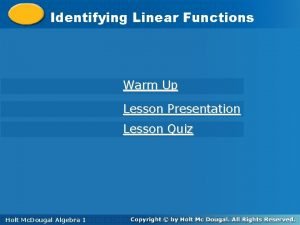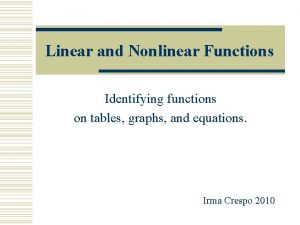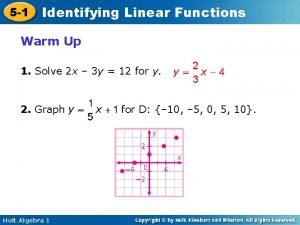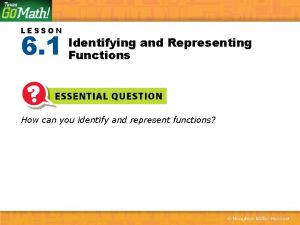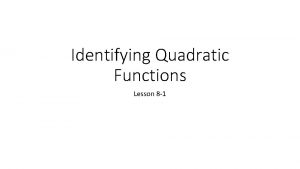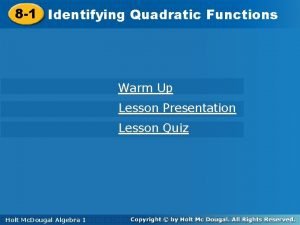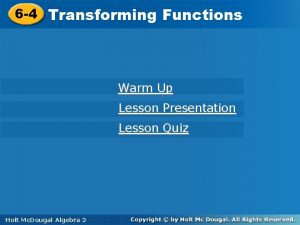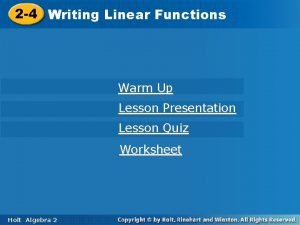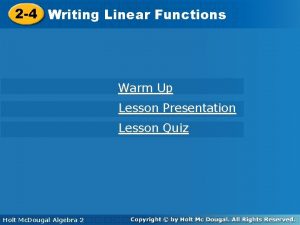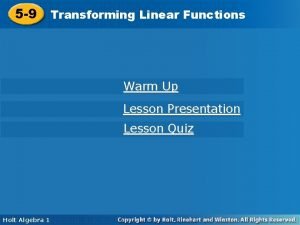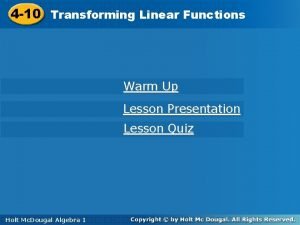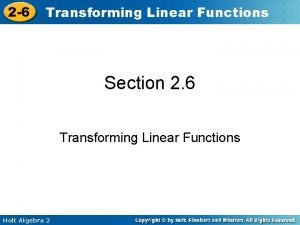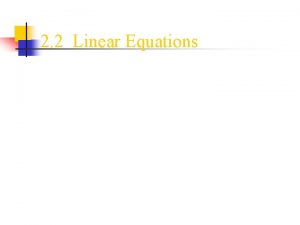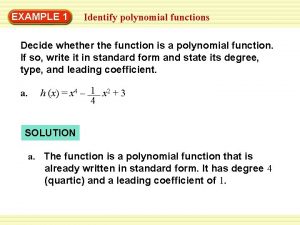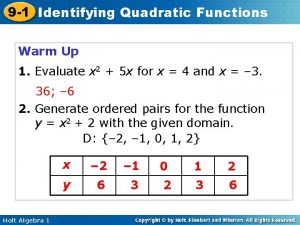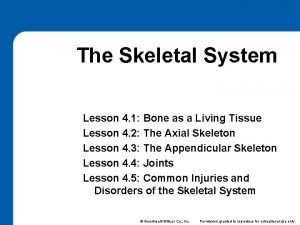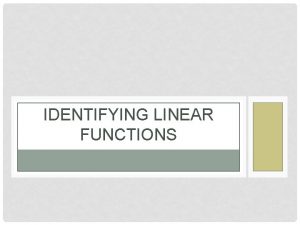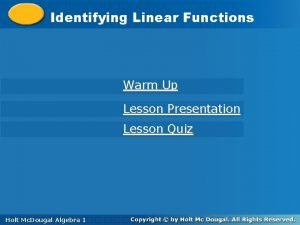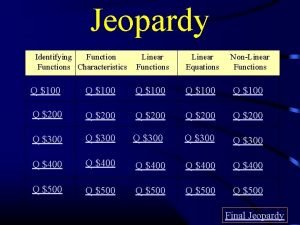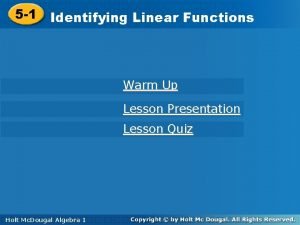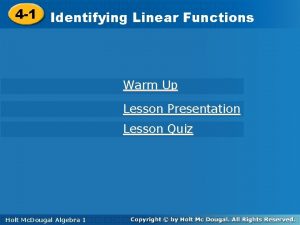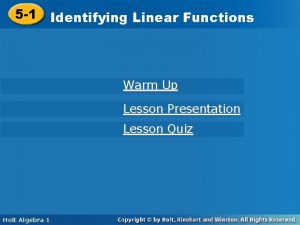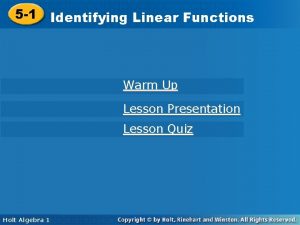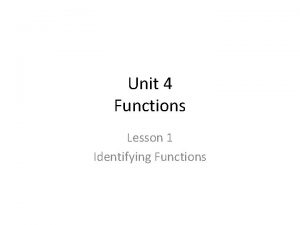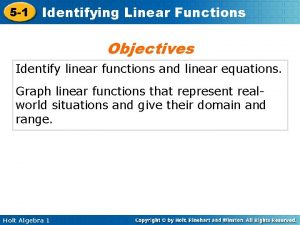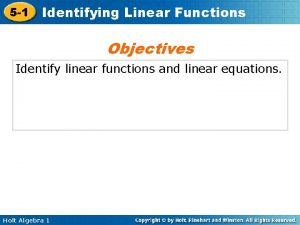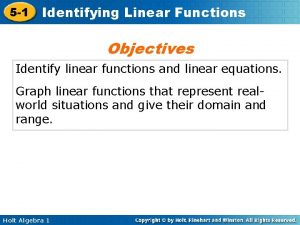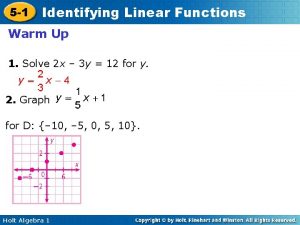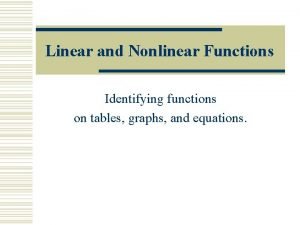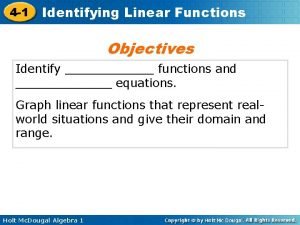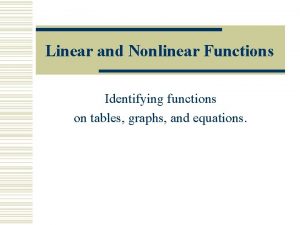5 1 Identifying Linear Functions Warm Up Lesson






















- Slides: 22

5 -1 Identifying. Linear. Functions Warm Up Lesson Presentation Lesson Quiz Holt Algebra 1

5 -1 Identifying Linear Functions The graph represents a function because each domain value (x-value) is paired with exactly one range value (y-value). Notice that the graph is a straight line. A function whose graph forms a straight line is called a linear function. Holt Algebra 1

5 -1 Identifying Linear Functions Example 1 A: Identifying a Linear Function by Its Graph Identify whether the graph represents a function. Explain. If the graph does represent a function, is the function linear? Each domain value is paired with exactly one range value. The graph forms a linear function Holt Algebra 1

5 -1 Identifying Linear Functions Example 1 B: Identifying a Linear Function by Its Graph Identify whether the graph represents a function. Explain. If the graph does represent a function, is the function linear? Each domain value is paired with exactly one range value. The graph is not a linear function Holt Algebra 1

5 -1 Identifying Linear Functions Example 1 C: Identifying a Linear Function by Its Graph Identify whether the graph represents a function. Explain. If the graph does represent a function, is the function linear? The only domain value, – 2, is paired with many different range values. not a function Holt Algebra 1

5 -1 Identifying Linear Functions Check It Out! Example Identify whether the graph represents a function. Explain. If the graph does represent a function, is the function linear? Each domain value is not paired with exactly one range value. not a function Holt Algebra 1

5 -1 Identifying Linear Functions You can sometimes identify a linear function by looking a table or a list of ordered pairs. In a linear function, a constant change in x corresponds to a constant change in y. Holt Algebra 1

5 -1 Identifying Linear Functions The points from this table lie on a line. In this table, a constant change of +1 in x corresponds to constant change of – 3 in y. These points satisfy a linear function. Holt Algebra 1

5 -1 Identifying Linear Functions The points from this table do not lie on a line. In this table, a constant change of +1 in x does not correspond to a constant change in y. These points do not satisfy a linear function. Holt Algebra 1

5 -1 Identifying Linear Functions Example 2 A: Identifying a Linear Function by Using Ordered Pairs Tell whether the set of ordered pairs satisfies a linear function. Explain. {(0, – 3), (4, 0), (8, 3), (12, 6), (16, 9)} x +4 +4 Holt Algebra 1 y 0 – 3 4 0 8 3 12 6 16 9 +3 +3 Write the ordered pairs in a table. Look for a pattern. A constant change of +4 in x corresponds to a constant change of +3 in y. These points satisfy a linear function.

5 -1 Identifying Linear Functions Example 2 B: Identifying a Linear Function by Using Ordered Pairs Tell whether the set of ordered pairs satisfies a linear function. Explain. {(– 4, 13), (– 2, 1), (0, – 3), (2, 1), (4, 13)} +2 +2 Holt Algebra 1 x y – 4 13 – 2 1 0 – 3 2 1 4 13 – 12 – 4 +4 +12 Write the ordered pairs in a table. Look for a pattern. A constant change of 2 in x corresponds to different changes in y. These points do not satisfy a linear function.

5 -1 Identifying Linear Functions Another way to determine whether a function is linear is to look at its equation. A function is linear if it is described by a linear equation. A linear equation is any equation that can be written in the standard form shown below. Holt Algebra 1

5 -1 Identifying Linear Functions Notice that when a linear equation is written in standard form • x and y both have exponents of 1. • x and y are not multiplied together. • x and y do not appear in denominators, exponents, or radical signs. Holt Algebra 1

5 -1 Identifying Linear Functions Holt Algebra 1

5 -1 Identifying Linear Functions Example 3 A: Graphing Linear Functions Tell whether the function is linear. If so, graph the function. x = 2 y + 4 – 2 y x – 2 y = 4 Write the equation in standard form. Try to get both variables on the same side. Subtract 2 y from both sides. The equation is in standard form (A = 1, B = – 2, C = 4). The equation can be written in standard form, so the function is linear. Holt Algebra 1

5 -1 Identifying Linear Functions Example 3 B: Graphing Linear Functions Tell whether the function is linear. If so, graph the function. xy = 4 This is not linear, because x and y are multiplied. It is not in standard form. Holt Algebra 1

5 -1 Identifying Linear Functions Check It Out! Example Tell whether the function is linear. If so, graph the function. y = 12 The equation is in standard form (A = 0, B = 1, C = 12). The equation can be written in standard form, so the function is linear. Holt Algebra 1 y

5 -1 Identifying Linear Functions Check It Out! Example Tell whether the function is linear. If so, graph the function. y = 2 x This is not linear, because x is an exponent. Holt Algebra 1

5 -1 Identifying Linear Functions Example 4: Application The relationship between human years and dog years is given by the function y = 7 x, where x is the number of human years. Graph this function and give its domain and range. Choose several values of x and make a table of ordered pairs. x f(x) = 7 x 1 f(1) = 7 2 f(2) = 7(2) = 14 3 f(3) = 7(3) = 21 Holt Algebra 1 (3, 21) • • (2, 14) • (1, 7)

5 -1 Identifying Linear Functions Check It Out! Example 4 What if…? At a salon, Sue can rent a station for $10. 00 per day plus $3. 00 per manicure. The amount she would pay each day is given by f(x) = 3 x + 10, where x is the number of manicures. Graph this function and give its domain and range. Holt Algebra 1

5 -1 Identifying Linear Functions Lesson Quiz: Part I Tell whether each set of ordered pairs satisfies a linear function. Explain. 1. {(– 3, 10), (– 1, 9), (1, 7), (3, 4), (5, 0)} No; a constant change of +2 in x corresponds to different changes in y. 2. {(3, 4), (5, 7), (7, 10), (9, 13), (11, 16)} Yes; a constant change of +2 in x corresponds to a constant change of +3 in y. 3. y = 3 – 2 x 4. 3 y = 12 yes Holt Algebra 1 no

5 -1 Identifying Linear Functions Lesson Quiz: Part II 5. The cost of a can of iced-tea mix at Save More Grocery is $4. 75. The function f(x) = 4. 75 x gives the cost of x cans of iced-tea mix. Graph this function and give its domain and range. D: {0, 1, 2, 3, …} R: {0, 4. 75, 9. 50, 14. 25, …} Holt Algebra 1
 Identify linear functions
Identify linear functions Linear and nonlinear tables worksheet
Linear and nonlinear tables worksheet 5-1 identifying linear functions answer key
5-1 identifying linear functions answer key Lesson 6-1 identifying and representing functions
Lesson 6-1 identifying and representing functions Lesson 8 quadratic functions page 339
Lesson 8 quadratic functions page 339 8-1 identifying quadratic functions
8-1 identifying quadratic functions Identifying and non identifying adjective clauses
Identifying and non identifying adjective clauses Identifying and non identifying adjective clauses
Identifying and non identifying adjective clauses Identifying and non identifying adjective clauses
Identifying and non identifying adjective clauses Horizontal stretch example
Horizontal stretch example Transforming linear functions lesson 6-4
Transforming linear functions lesson 6-4 Lesson 4-10 transforming linear functions answers
Lesson 4-10 transforming linear functions answers 3-3 lesson quiz transforming linear functions answer key
3-3 lesson quiz transforming linear functions answer key 2-4 writing linear equations
2-4 writing linear equations Problem 3
Problem 3 Transforming linear functions lesson 6-4
Transforming linear functions lesson 6-4 Transforming linear functions lesson 6-4
Transforming linear functions lesson 6-4 Transforming linear functions lesson 6-4
Transforming linear functions lesson 6-4 Standard form linear equation
Standard form linear equation Direct substitution polynomial
Direct substitution polynomial Identifying even and odd functions
Identifying even and odd functions 9-1 identifying quadratic functions
9-1 identifying quadratic functions Lesson 4.1: anatomical structure of a long bone
Lesson 4.1: anatomical structure of a long bone
